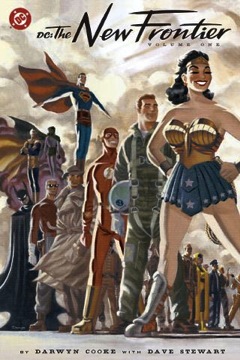Breaking Into Comics: 'DC: The New Frontier'
Eric Gaudette ‘15 / Emertainment Monthly Staff Writer
The Justice League movie has finally been approved for release in 2017, serving as a late response to Marvel’s Avengers. The problem is a lot of the heroes in the Justice League won’t have a standalone movie beforehand, giving little time to introduce and develop characters, like Green Lantern, The Flash and anyone else Warner Bros. decides to add to the roster. Going into the Avengers, viewers already knew about Iron Man and Captain America’s background because they saw their respective films. So the question is: how can DC top The Avengers by introducing another team of superheroes in one cohesive, self-contained narrative?
It turns out, DC already did just that ten years ago in comic form. It was called DC: The New Frontier, a six-issue miniseries.

What makes Frontier especially great for newcomers is that writer and artist Darwyn Cooke knew what he had to explain. Heroes like Batman and Superman don’t need much explanation. Everyone has seen that iconic image of young Bruce kneeling in between his murdered parents. Instead, the narrative mostly focuses on so-called “B-list” heroes like The Flash (Barry Allen), the Green Lantern (Hal Jordan), the Martian Manhunter (“John Jones”). But the thing is, for the majority of the narrative we don’t see the latter two characters as superheroes. Hal Jordan is just a man who wants to see the stars, until he receives that otherworldly ring late into the series. The Martian Manhunter wants to do good, but rather than donning tights and fighting crime out in the open, he joins Gotham’s police force. Even Barry Allen, who has been the Flash for a while in this particular continuity, doesn’t consider himself a real superhero. He actually believes that the country sees him as a traitor.
The story mostly takes place in the fifties. World War II ended, America’s economy and technological advances are almost unparalleled, and the Red Scare is sweeping the nation. There was a team of superheroes prior to this story called the Justice Society, but it’s been disbanded as a new law dictates that any and all men and women in costumes have to work for Uncle Sam directly. As such, only Wonder Woman and Superman are recognized superheroes—other folks like Batman and Green Arrow have to work under the radar. The series centers around various heroes (not all of them super) trying to combat a mysterious being called The Centre, which turns out to be something Earth has never seen. And since this Earth has super-intelligent, evil gorillas, and a man who can create a deafening boom with just a small clap, that’s saying something.
But they don’t actually confront this monstrosity until the very end of the series. Instead, they all face their unique trials and tribulations before the final battle. Rather, the Centre is really the entity that brings them all together. The story instead focuses on the heroes dealing with personal issues. The Martian Manhunter is teleported from Mars, and is trying to find a way back home while at the same time, trying to make a difference in his new, adopted home. Hal Jordan is part of a Mars mission while he struggles to deal with his past. Wonder Woman has to deal with her new position as a government agent, which her best friend, Superman, can’t seem to relate to as well. While they certainly don’t live ordinary lives, it’s possible to see the humanity in all of them, even Superman, who even in this universe seems unstoppable.

Rather than a number of different established superheroes coming together in the end, audiences have people who realize their super-heroic potential by coming to America’s aid when it needs them most. The society in this comic reacts the same way people do when they see these characters—most of whom are not yet heroes—try to conquer their own insecurities as they rise to the occasion. Never are these characters portrayed as some high-unstoppable forces of nature that can’t be beaten. The Flash almost gets overpowered by a government agent at one point! Viewers don’t see these characters for what they’re capable of, but rather as relatable, interesting characters who people genuinely want to see succeed. Not because people want to see a big action sequence in the end—but because they want these guys to win.
While it’s unlikely this story will be adapted to the big screen, it’s perfect in its glorious comic book form. The amount of detail that Cooke puts into each character’s narration, coupled with the ‘50s-inspired visuals make this a unique experience. DC: The New Frontier is available digitally and on paperback. Additionally, it’s been adapted into a direct-to-DVD movie, Justice League: The New Frontier. While this adaptation isn’t bad per se, it cuts a lot things out and ultimately doesn’t do justice to Cooke’s work. If anyone is looking for an introduction to the DC Universe and the characters that will most likely be featured in the Justice League movie, look no further than this miniseries.